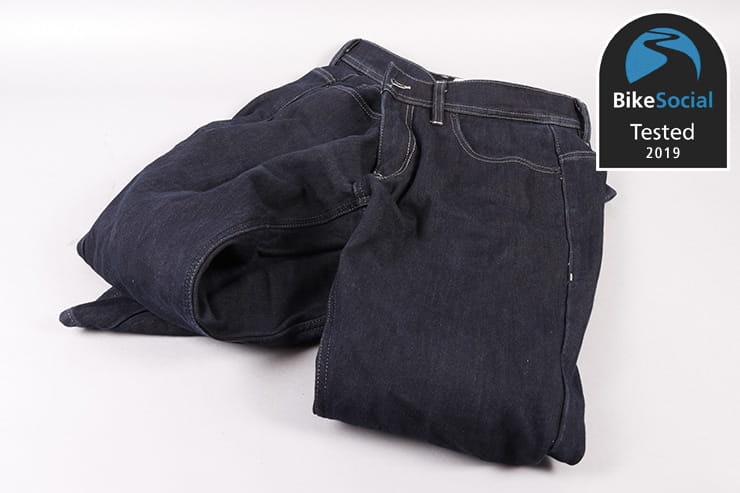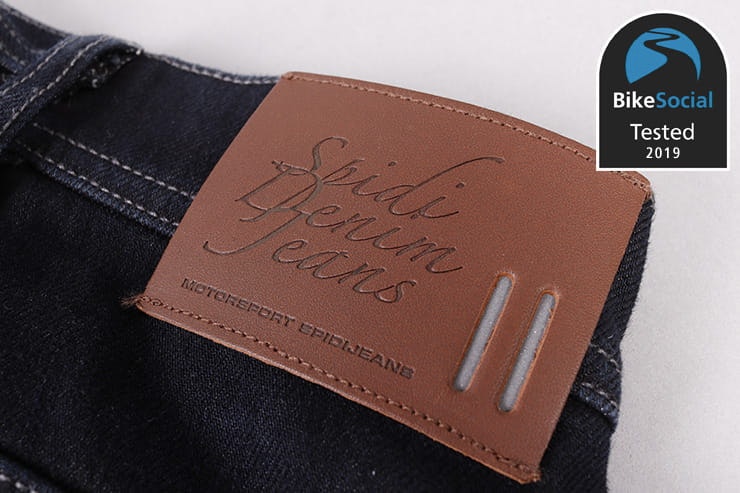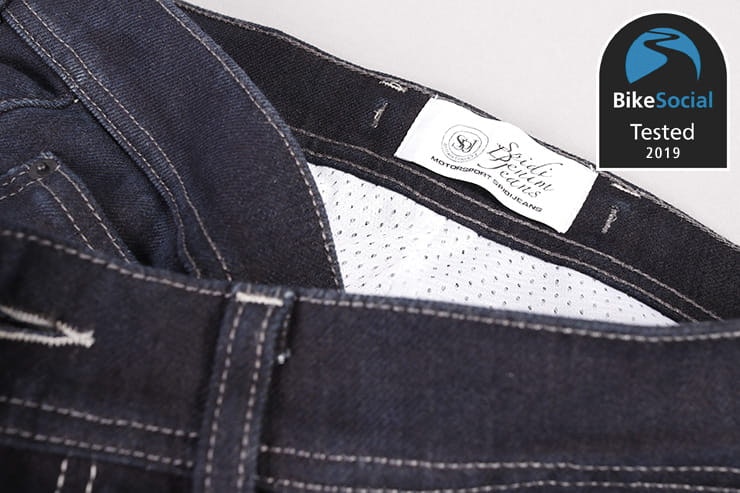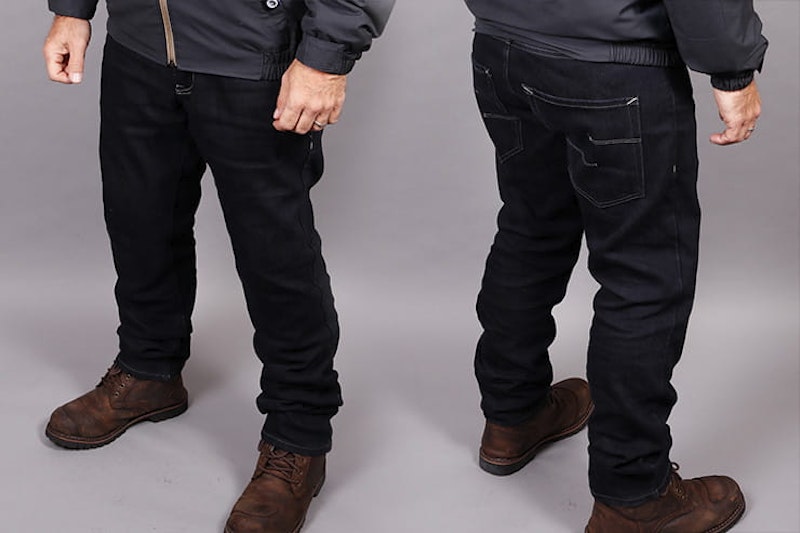Tested: Spidi J&Dyneema motorcycle jeans review
By Stephen Lamb
Production Manager
06.09.2019
Date reviewed: September 2019 | Tested by: Steve Lamb | Price: £299.90 | www.spidi.co.uk
I've been wearing these Spidi J&Dyneema jeans for around three months and have done over 1,500 miles of leisure riding and commuting in that time on a variety of bikes including my own Ducati Scrambler, a KTM 1290 Super Duke GT, Suzuki Katana and Honda CBR650R.
Fit
The major fault with men's clothing is that trousers are primarily ordered by waist size. Therefore, for those of us with less athletic figures, a 34" waist is assumed to be accompanied by a 32" leg length – not the 29" that I have, being just around 5'6".
For me then, most jeans, unless specifically ordered as short leg, are too long and the Spidi J&Dyneema jeans are no exception. When ordered as 34" waist these come in a 33" inside leg.
Despite the extra-long leg though, the rest of the fit is very good. The adjustable knee armour can be placed in just the right location for use both on and off the bike, and the fit around the waist and groin is also very good, with no unsightly bulges or saggy bottoms. I did find though that the rear pockets are very low down on the bum, but this a design feature, rather than a result of poor fit.
The hips are a little snug due to the inclusion of the D3O armour, but these are easily removed should you wish to put comfort over protection.
Protection and certification
Unlike fully or partially lined jeans we’ve recently tested, the J&Dyneema jeans have no internal lining at all. This is because the aramid thread is woven straight into the fabric of the jeans. While this does effectively provide 100% coverage, the inclusion of the threads within the weave of the fabric means that the effect of the aramid is 'diluted' by the cotton of the denim. In the case of these jeans, the mix is 60% Dyneema, 38% cotton and 2% elastane. Of course, cotton has its own abrasion-resistant qualities, though despite the concern that as the outer wears naturally, so protection is reduced, these jeans are approved to prEN17092:2017 Level AA.
The J&Dyneema Jeans are supplied with flexible armour to the knee and hip areas. Knee armour in held in place within the liner, with a 6cm x 3cm patch of Velcro allowing for considerable adjustment of height (by about 8cm). The armour in the hips is not adjustable. All the armour is CE approved to EN1621-1 Level 1.
From April 21 2018, all new motorcycle clothing is deemed to be Personal Protective Equipment (PPE). To meet this legislation, it must be tested to a recognised standard. For more information on the law, click here.
Note: Some stores and brands claim ‘official CE test slide times’ to promote the abrasion resistance of the jeans they sell. The only CE testing that gives a time is through using the Cambridge machine, which sees samples of the clothing dropped onto a moving 60 grit abrasive belt, and timed to failure. However, this has only ever been considered a ‘relative abrasion time’ to compare products and MUST NOT be confused with a real-world crash protection time.
We’ve also seen times as high as almost seven seconds and beyond claimed, contrary to testing we had carried out by an independent notified body when looking for the best motorcycle jeans.
Our recommendation would be to ignore these claims and focus on the testing required for the current PPE regulations until clear evidence is provided, either through the Bennetts High Performance Award scheme, or through seeing a COMPLETE and verifiable test certificate from a notified body.
Pockets
The usual compliment of pockets for a pair of jeans are provided – two at the front, plus a watch pocket, and two at the back.
The pockets are generous in cut allowing you to carry keys, phones and general detritus with ease and with no fear of losing your valuables when out riding. The insides of the pockets are cotton, which may not last as long as the jeans, but again, a local tailor or alteration service would be able to replace these if they wear out and you really didn’t want new jeans.
Fastening
Fastening is as you would expect – a good quality large metal button and heavy-duty zip to the front. The jeans also have belt loops to allow you to further tighten the waist on your thin days. Due to the inclusion of 2% elastane to the material, there is a good stretch to the fabric ensuring that you can get a nice tight fit and closure.
Warmth
Even unlined jeans are a little warmer and heavier than normal fashion jeans (these weigh around 15oz/yard2 in comparison to 'normal' denim at around 12oz/yrd2), so this may limit your desire to wear them for a full day in the office, for example. But out on the bike they do a good job of reducing wind blast and breezes. They are never going to be good enough to wear in the winter, but for late spring and early autumn rides when you’re looking for a bit more comfort than leathers, they do the job very well.
In extreme temperatures (well, extreme for the UK) of 30°C+, they soon become uncomfortably hot but thankfully not too sweaty and sticky. I doubt that any trousers – leather, jean or textile – would cope any better with these temperatures though.
Liner
The jeans are fitted with a perforated 100% polyamide internal liner that serves three functions – to hold the CE approved armour in place, to reduce friction between the demin and the skin in the event of contact with the road and finally to aid comfort and provide a cool-feel lining against the skin. The lining extends from the waist band to below the knee in the front and to a little below the bum in the rear. Around the knee armour, the lining is doubled to provide a pocket into which the armour is fitted.
I find the lining to be very comfortable in all conditions and temperatures, providing just enough separation between the denim and my skin to allow some airflow and prevent overheating or sweatiness.
Just a bit too long...
Conclusion
It’s a shame that the legs are so long as standard, but don't forget that bike jeans can be taken up, just the same as fashion jeans. I've previously used my local independent tailor who charged around £30 for taking up jeans, or you can use dry-cleaners such as Johnsons, or supermarket kiosk based services such as Timpsons.
Despite the additional length – and once I'd got used to the extra bulk of these jeans – they soon became my go-to for more casual rides and some guaranteed dry commuting.
The constant fear of being caught out in the rain prevents reliable everyday wear, which is a shame as they’re comfortable and smart enough for a full day in the (air-conditioned) office.
At this price point however, there seems no obvious reason to buy these unlined jeans when there are a full range of fully-lined jeans available, which not only offer equal or greater protection, but also cost around half as much.



